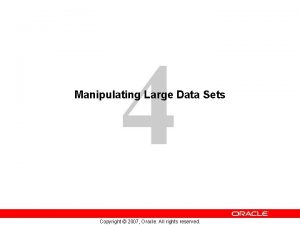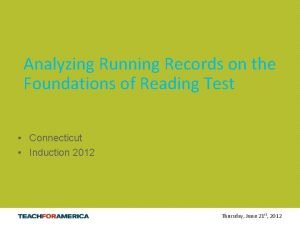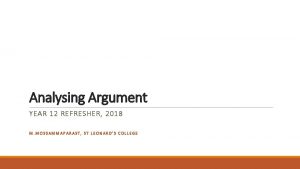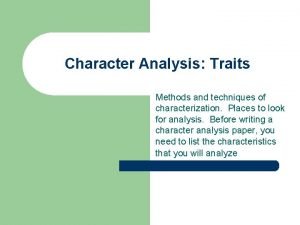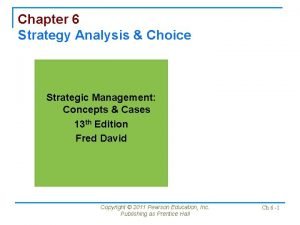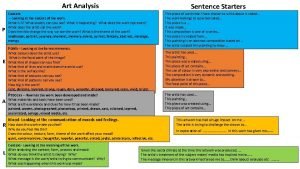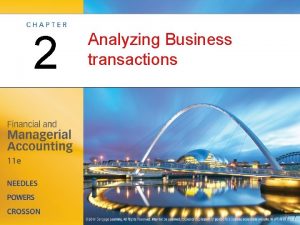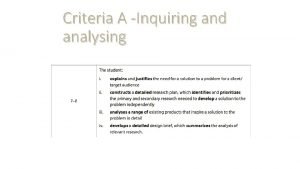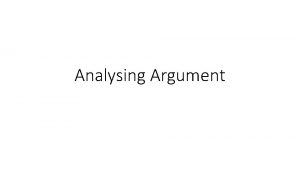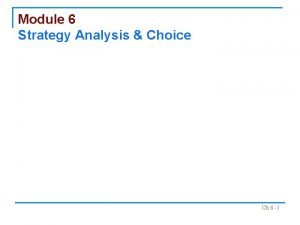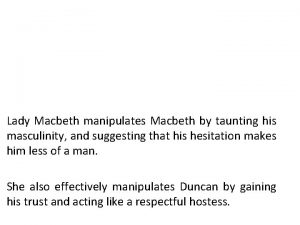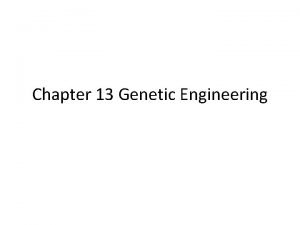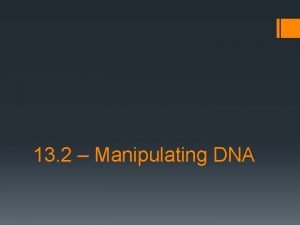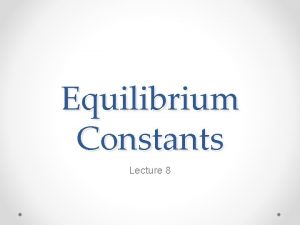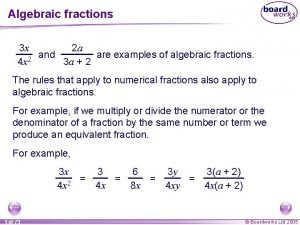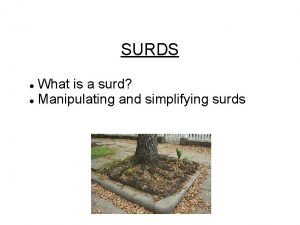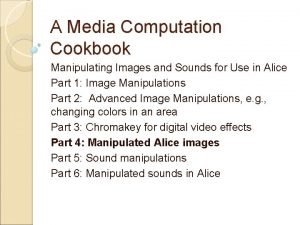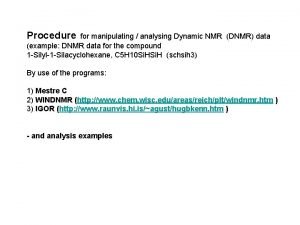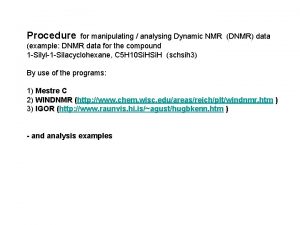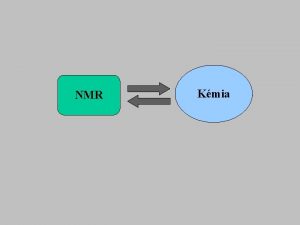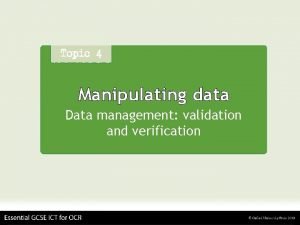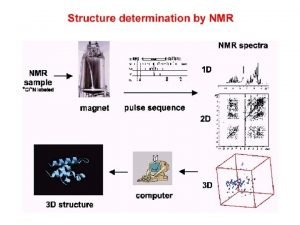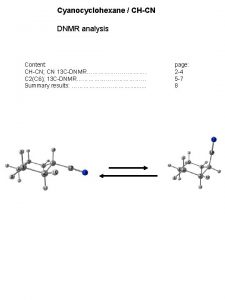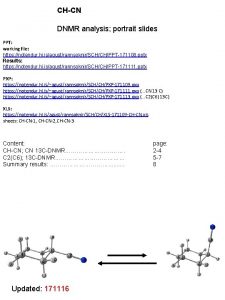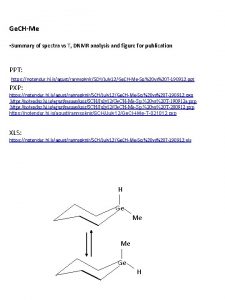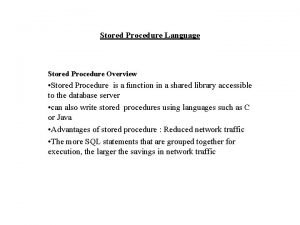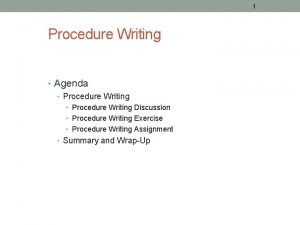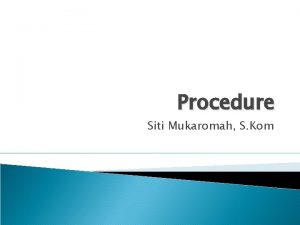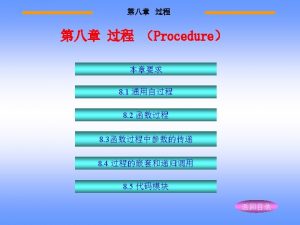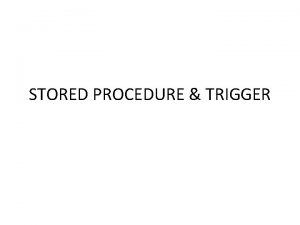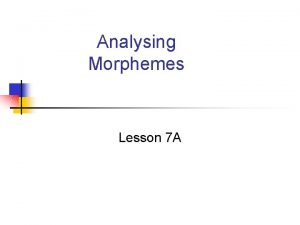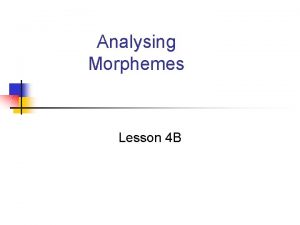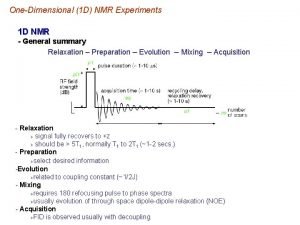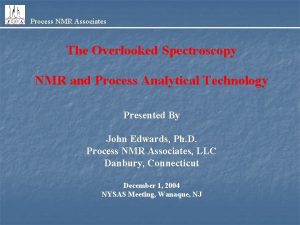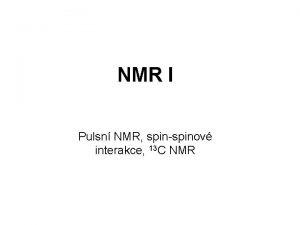Procedure for manipulating analysing Dynamic NMR DNMR data







































- Slides: 39

Procedure for manipulating / analysing Dynamic NMR (DNMR) data (example: DNMR data for the compound 1 -Silyl-1 -Silacyclohexane, C 5 H 10 Si. H (schsih 3) By use of the programs: 1) Mestre C 2) WINDNMR (http: //www. chem. wisc. edu/areas/reich/plt/windnmr. htm ) 3) IGOR (http: //www. raunvis. hi. is/~agust/hugbkenn. htm ) - and analysis examples

Procedure (example: DNMR data for the compound ): nuts files (necessary input files for WINDNMR) are created with Mestre C as (inside Mestre C): File->import spectra->. . schsih 3 -> FIF gogn-> Select for example sow 417 mr. 163 ->open->FT -> 256 K->Apply along t 1 -> Phase correction(if needed): select region of interest by using magnifying glass(+) and click and drag untill satisfactory-> press phase correction button->click mouse as said and hold and drag up or down and you will see the phase change; stop when it is good ->OK->File->Export file -> nuts->. . . appropriate file-> type name: schsih 3 -163. nts->save Now schsih 3 -163. nts should be ready for WINDNMR to read: Inside WINDNMR (has to be without some other experimental spectrum inside): File->open new spectrum->. . select appropriate file>select schsih 3 -163. nts->open-> select the spectrum area of interest by click, drag drop and choose “Expand spectrum”; You may need to do this several time untill you ar happy. NB!: Simulation er framkvæmd manually, þ. e. með því að breyta parametrum handvirkt og lágmarka error og/eða með því að fá besta sjónræna fit! Move date from WINDNMR to IGOR: After simulation has been performed inside WINDNMR: Export->Spectrum data to Clipboard (for spreadsheet)-> move to a table inside IGOR and simply paste => calculated and experimental spectra are copied to four columns as: 1 st column: x axis values for calc. ; 2 nd column: y axis values for calc. ; 3 rd column: x axis values for exp. ; 4 st column: y axis values for exp. ;

Analysis examples are shown below:

“Difference spectrum” = exp. – calc. exp. Tcorr = 100. calc. 120509: item 1, simulation group schsih 3 -105 -32 K. sim, C 3, C 5; see parameters above and/or in table;

“Difference spectrum” = exp. – calc. exp. Tcorr = 110. calc. 120509: item 1, simulation group schsih 3 -115 -32 K. sim, C 3, C 5; see parameters above and/or in table;

“Difference spectrum” = exp. – calc. Tcorr = 115. exp. calc. 120509: item 2, simulation group schsih 3 -124 -32 K. sim, C 3, C 5; see parameters above and/or in table;

“Difference spectrum” = exp. – calc. Tcorr = 122. exp. calc. 120509: item 1, simulation group schsih 3 -132 -32 K. sim, C 3, C 5; see parameters above and/or in table;

“Difference spectrum” = exp. – calc. Tcorr = 123. calc. exp. 120509: item 1, simulation group schsih 3 -133 -32 K. sim, C 3, C 5; see parameters above and/or in table;

“Difference spectrum” = exp. – calc. Tcorr = 128. exp. calc. 120509: item 1, simulation group schsih 3 -138 -32 K. sim, C 3, C 5; see parameters above and/or in table;

“Difference spectrum” = exp. – calc. Tcorr = 135. exp. calc. 120509: item 1, simulation group schsih 3 -145 -32 K. sim, C 3, C 5; see parameters above and/or in table;

“Difference spectrum” = exp. – calc. Tcorr = 138. exp. calc. 120509: item 1, simulation group schsih 3 -148 -32 K. sim, C 3, C 5; see parameters above and/or in table;

“Difference spectrum” = exp. – calc. exp. Tcorr = 100. calc. 120509: item 2, simulation group schsih 3 -105 -32 K. sim, C 2, C 6; see parameters above and/or in table;

“Difference spectrum” = exp. – calc. exp. Tcorr = 110. calc. 120509: item 2, simulation group schsih 3 -115 -32 K. sim, C 2, C 6; see parameters above and/or in table;

“Difference spectrum” = exp. – calc. Tcorr = 115. calc. exp. 120509: item 3, simulation group schsih 3 -124 -32 K. sim, C 2, C 6; see parameters above and/or in table;

“Difference spectrum” = exp. – calc. exp. calc. Tcorr = 122. 120509: item 2, simulation group schsih 3 -132 -32 K. sim, C 2, C 6; see parameters above and/or in table;

“Difference spectrum” = exp. – calc. Tcorr = 123. calc. exp. 120509: item 2, simulation group schsih 3 -133 -32 K. sim, C 2, C 6; see parameters above and/or in table;

“Difference spectrum” = exp. – calc. Tcorr = 128. calc. exp. 120509: item 2, simulation group schsih 3 -138 -32 K. sim, C 2, C 6; see parameters above and/or in table;

“Difference spectrum” = exp. – calc. Tcorr = 135. exp. calc. 120509: item 2, simulation group schsih 3 -145 -32 K. sim, C 2, C 6; see parameters above and/or in table;

“Difference spectrum” = exp. – calc. Tcorr = 154. exp. calc. 120509: item -, simulation group schsih 3 -163. sim, C 2, C 6; see parameters above and/or in table;

Tcorr = 154. exp. calc. 120509: item -, simulation group schsih 3 -163. sim, C 2, C 6; see parameters above and/or in table;

Tcorr = 128. calc. exp. 120509: item 3, simulation group schsih 3 -138 -32 K. sim, C 2, C 6; see parameters above and/or in table;

“Difference spectrum” = exp. – calc. exp. calc. Tcorr = 123. 120509: item 3, simulation group schsih 3 -133 -32 K. sim, C 2, C 6; see parameters above and/or in table;

“Difference spectrum” = exp. – calc. exp. calc. Tcorr = 122. 120509: item 3, simulation group schsih 3 -132 -32 K. sim, C 2, C 6; see parameters above and/or in table;

“Difference spectrum” = exp. – calc. Tcorr = 115. calc. exp. 120509: item 4, simulation group schsih 3 -124 -32 K. sim, C 2, C 6; see parameters above and/or in table;

“Difference spectrum” = exp. – calc. Tcorr = 110. exp. calc. 120509: item 3, simulation group schsih 3 -115 -32 K. sim, C 2, C 6; see parameters above and/or in table;

“Difference spectrum” = exp. – calc. Tcorr = 100. calc. exp. 120509: item 3, simulation group schsih 3 -105 -32 K. sim, C 2, C 6; see parameters above and/or in table;

WINDNMR analysis for SCH-Si. H 3 , C 3, C 5: Tcorr kab + kba %a 100 0 54 110 7 58 115 39 57 122 400 54 (assumed) 123 400 54 (assumed) 128 1100 54 (assumed) 135 9500 54 (assumed) 138 13500 54 (assumed) Low field a b eq ax High field NB!: This data needs to be used to derive K, A and DG#

WINDNMR analysis for SCH-Si. H 3 , C 2, C 6: Tcorr kab + kba %a 100 15 56 115 39 56 122 400 56 (assumed) 123 400 56 (assumed) 128 1100 56 (assumed) 135 9500 56 (assumed) 154 ¥ (95000) 56 (assumed) Low field a b eq ax High field NB!: This data needs to be used to derive K, A and DG#

130509: Paper by Hans J. Reich , Birgir Ö. Guðmundsson et al. Including rate constant detemination by WINDNMR et c. : See: http: //www. chem. wisc. edu/areas/reich/papers/Reich-2001 -JACS-123, 8067 -Amine-chelated-aryllithium. pdf Good ref. for standard transition state theory, which relates DG# and kab is: http: //arxiv. org/ftp/arxiv/papers/0706. 1504. pdf (see also my notes, 130509; 1 -2) Main eq. : eq ; k = rate constant ax DG# eq 56% ax 44% DGeq, ax

DGeq, ax and Keq, ax : Keq, ax = 44/56 = 0. 786: DGeq, ax = A = -RT ln(Keq, ax); T = average T where K is determined in experiment, i. e. in the regin 100 – 115 K, = <T> = say 110 K DGeq, ax = A =Gax - Geq = -8. 315 (J K-1 mol-1)*110(T) ln(0. 786) = 0. 22 k. J mol-1 = 0. 053 kcal mol-1; (see below) More details (from excel): parameter value unit R 8. 315 T 110 K 0. 785714286 %a 56 %b 44 J K-1 mol-1 K - DGeq, ax 220. 5788753 J mol-1 DGeq, ax 0. 220578875 k. J mol-1 DGeq, ax 5. 27 E-02 kcal mol-1 conversion factor 2. 39 E-01 kcal/k. J Does this make sense? 1)

1) To be compared, for example, with A = Gax – Geq = +0. 4 kcal mol-1 derived for T = 113 for SCH-CF 3, See: http: //www 3. hi. is/~agust/ritsmidar/SCHCF 3 nmredabinitio-0207. pdf Determinaton of individual rate constants from the equilibrium constant (Keq, ax) and “the rate constant sum” (kab + kba = ksum) which is derived from the temperature dependend NMR data Comment / NB!: kab = keq, ax ; kba = kax, eq Keq, ax = keq, ax/kax, eq; keq, ax + kax, eq = ksum; => keq, ax = ksum /(1 + (Keq, ax)-1) kax, eq = ksum /(1 + Keq, ax)

Analysis for SCH-Si. H 3 , C 3, C 5: Keq, ax = 0. 786 T /K keq, ax + kax, eq = ksum keq, ax /s-1 kax, eq /s-1 DG#/ kcal mol-1 100 0 110 7 3 4 6. 0 115 39 17 22 5. 9 122 400 176 224 5. 7 123 400 176 224 5. 7 128 1100 484 616 5. 7 135 9500 4181 5319 5. 5 138 13500 5941 7559 5. 5 Does this make sense? ! : This can be compared with the value 5. 5 kcal mol-1 for SCH-CF 3, with coalescence point near 113 K. (http: //www 3. hi. is/~agust/ritsmidar/SCHCF 3 nmredabinitio-0207. pdf ) ERGO: yes it makes sense!

Analysis for SCH-Si. H 3 , C 2, C 6: Does this make sense? ! : Keq, ax = 0. 786 Tcorr keq, ax + kax, eq = ksum keq, ax /s-1 kax, eq /s-1 DG#/ kcal mol-1 100 15 7 8 5. 3 110 15 7 8 5. 8 115 39 17 22 5. 9 122 400 176 224 5. 7 123 400 176 224 5. 7 128 1100 484 616 5. 7 135 9500 4180 5319 5. 5 154 ¥ (95000) This can be compared with the value 5. 5 kcal mol-1 for SCH-CF 3, with coalescence point near 113 K. (http: //www 3. hi. is/~agust/ritsmidar/SCHCF 3 nmredabinitio-0207. pdf ) ERGO: yes it makes sense!

SCHSi. H 3, 130509 ak C 2, C 6, 13 C-NMR, 250 MHz Simulation: Calc. : solid fat line Exp. : solid thin line Average DG#eq, ax = 5. 7 kcal mol-1 Keq, ax = 0. 8 DGeq, ax = 0. 05 kcal mol-1 See also SCHSi. H 3 -simul. figs. -130509 ak. ppt

C 3, C 5 DG#/ kcal mol-1 ? Great uncertainty C 2, C 6 Average DG#eq, ax = 5. 7 kcal mol-1 T/k See also PC, AK, . . . /SCHSi. H 3 -DNMR-simul-figs-130509 ak. pxp

140509: WINDNMR analysis for SCH-Si. H 3 , C 4: Tcorr kab + kba %a 100 15 51 ? 1) 105 13 45 1) 110 24 46 ? ? 115 69 170 infinit Low field High field a b 46 (assumed) eq ax 53 (assumed) NB!: This data needs to be used to derive 1) K, A and DG# 1) Could it be that eq and ax are reversed here / for C 4?

140509: Tcorr(K) 164 115 110 105 100 SCH-Si. H 3 , C 4:

140509: C 3, C 5 data => Coefficient values ± one standard deviation a = 7. 9532 ± 0. 224 b = -0. 017993 ± 0. 00179 DG# T/K

140509: DG# = DH# – T DS# Coefficient values ± one standard deviation a = 7. 9532 ± 0. 224 = DH#eq, compl. kcal mol-1 b = -0. 017993 ± 0. 00179 = -DS# kcal mol-1 K-1 Þ DH#eq, compl. = + 8. 0 kcal mol-1 Þ DS#eq, compl. = +18 cal mol-1 K-1 Þ eq. complex involves increase in entropy i. e. : kcal mol-1 8 5 0 DH# complex DG# complex Eq.
 Analysing market data
Analysing market data Manipulating large data sets
Manipulating large data sets Mountain bike mania running record
Mountain bike mania running record Political cartoon exaggeration
Political cartoon exaggeration Analysing argument
Analysing argument The buying process starts when the buyer recognizes a
The buying process starts when the buyer recognizes a The prohibited chow pest
The prohibited chow pest Name methods of analysing character
Name methods of analysing character Matching stage of strategy formulation framework
Matching stage of strategy formulation framework Sentence starters for art
Sentence starters for art Analysis of business transactions
Analysis of business transactions Inquiring and analysing
Inquiring and analysing Analysing the 6 strategic options megxit
Analysing the 6 strategic options megxit Analysing argument
Analysing argument Analysing the 6 strategic options megxit
Analysing the 6 strategic options megxit Procedures of data collection
Procedures of data collection How is macbeth manipulated by his wife
How is macbeth manipulated by his wife Instructing conversing manipulating exploring
Instructing conversing manipulating exploring Section 13-2 manipulating dna
Section 13-2 manipulating dna 13-2 manipulating dna
13-2 manipulating dna Tea accessibility features
Tea accessibility features 13-2 manipulating dna
13-2 manipulating dna Equiibrium constant
Equiibrium constant Why study scalp care shampooing and hair conditioning
Why study scalp care shampooing and hair conditioning Algebraic fraction
Algebraic fraction Manipulating surds
Manipulating surds Process of manipulating images and sounds
Process of manipulating images and sounds Ascii value of space
Ascii value of space Dynamic propeller balancing equipment
Dynamic propeller balancing equipment Static data structures
Static data structures Dynamic dynamic - bloom
Dynamic dynamic - bloom Kontinuitetshantering
Kontinuitetshantering Typiska novell drag
Typiska novell drag Nationell inriktning för artificiell intelligens
Nationell inriktning för artificiell intelligens Returpilarna
Returpilarna Varför kallas perioden 1918-1939 för mellankrigstiden?
Varför kallas perioden 1918-1939 för mellankrigstiden? En lathund för arbete med kontinuitetshantering
En lathund för arbete med kontinuitetshantering Underlag för särskild löneskatt på pensionskostnader
Underlag för särskild löneskatt på pensionskostnader Personlig tidbok fylla i
Personlig tidbok fylla i Anatomi organ reproduksi
Anatomi organ reproduksi

